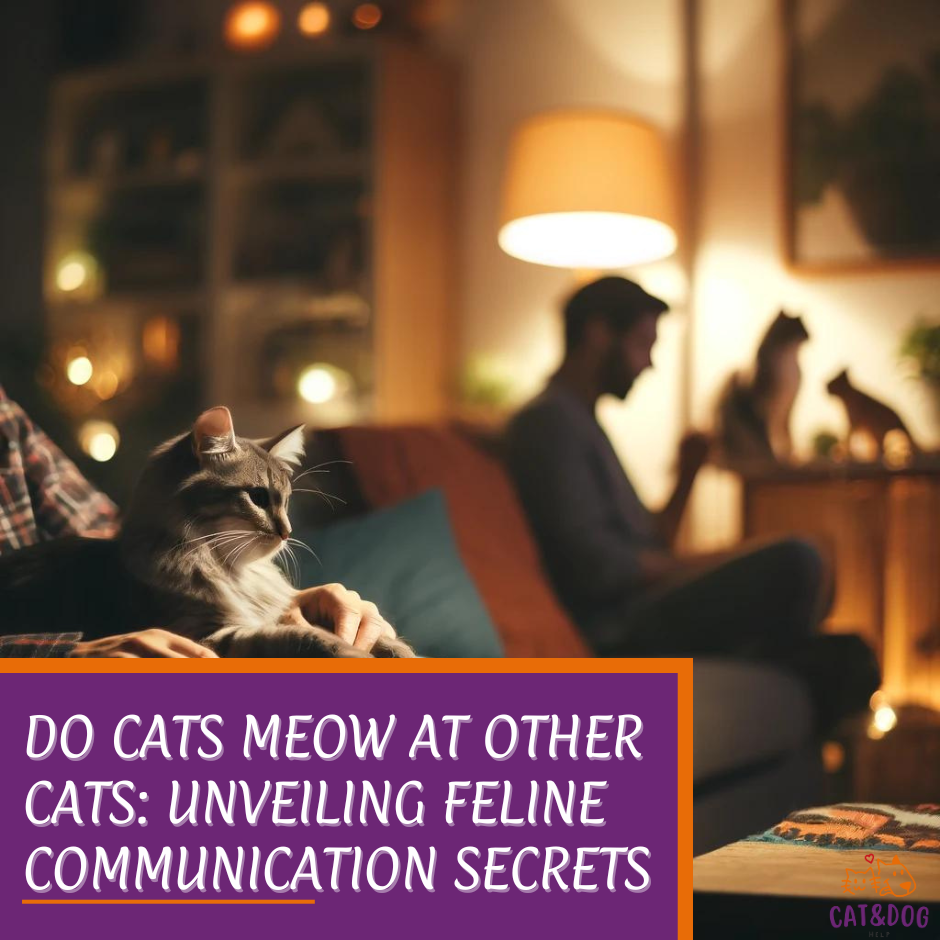You might have noticed that your feline friend is quite the conversationalist, especially with you, their beloved owner.
But have you ever wondered if your cat is chit-chatting with their furry peers using those distinctive meows?
Well, typically, cats reserve their vocal stylings mostly for humans, not for other cats.
do cats meow at other cats and how do they communicate with each other? so they communicate through scent, facial expression, complete body language, and touch. (1)
Meowing at humans is a behavior that domestic cats have developed to grab our attention, a fascinating fact considering wild cats rarely meow at each other or us.
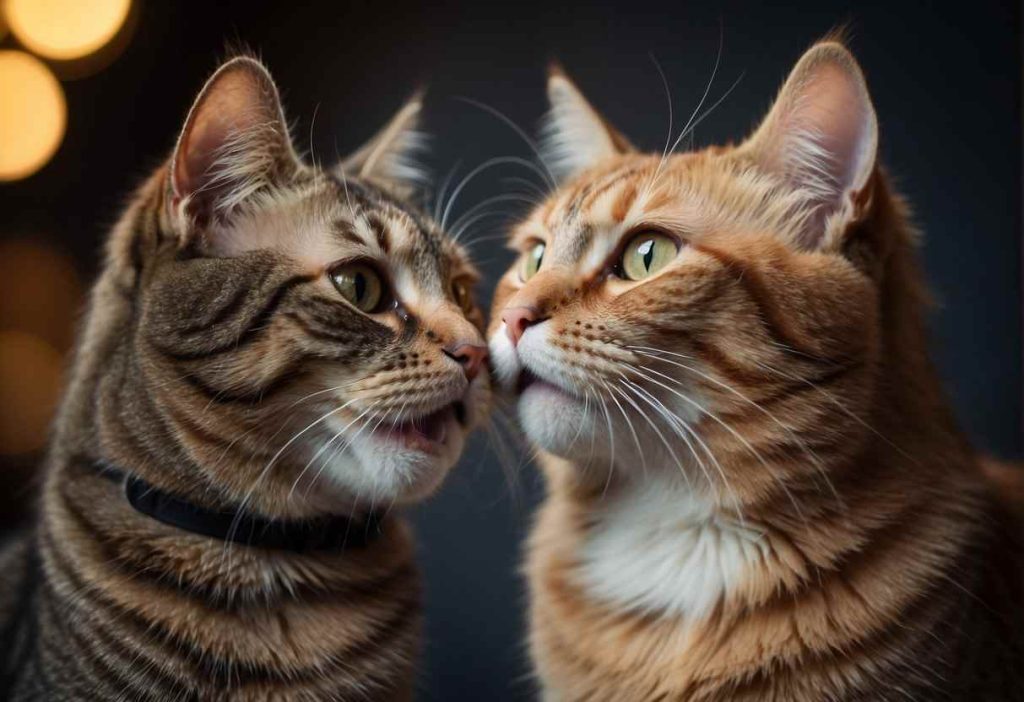
Understanding your cat’s meows can be quite beneficial.
By tuning into the nuances of your cat’s meows, you can enhance your bond with them, attending to their needs and comforts more effectively.
Cats meow for various reasons—to greet us, to indicate hunger, to convey pain or discomfort, or even just to say “Hey, look at me!”
Unraveling this vocal mystery can lead to a more harmonious living situation and a happy pet.
So, let’s talk about what your cat’s meowing might mean and how you can become fluent in the articulate language of meows. (2)
Key Takeaways
- Cats typically meow for human attention, not to communicate with other cats.
- Understanding a cat’s meows can improve the relationship between the pet and the owner.
- Meows can indicate a cat’s needs or desires, such as hunger or a desire for attention.
Do Cats Meow at Other Cats?
Understanding Cat Communication
- Have you ever caught your fluffy buddy meowing up a storm at you and wondered if they chat with other cats the same way?
- Cats are notorious for their diverse ways of communicating with both humans and their feline friends.
- Communication with Humans vs. Cats: While cats often meow to get our attention, it’s not their go-to method for conversing with other cats.
- Imagine that—it’s like they’ve got a secret handshake just for us humans!
The Language of Meows
- Did you know that cats’ meows are like snowflakes, with no two exactly alike?
- That’s right, your cat’s meow is as unique as their furry little self.
- Meanings Behind Meows: Pay attention to that symphony of sounds, as a meow could mean “feed me” “play with me,” or even “leave me alone, human!”
- Kittens and Mothers: Watch a mother cat with her kittens and you’ll see meowing is kitten-speak for “help!”
- As they grow, you’ll notice less meowing to each other and more silent communication like body language. (3)
Hey, you’ve just unlocked the secret to why your cat seems to only gossip with you and not with its cat buddy next door. Keep an ear out—your cat’s meows are a special language just for you!
Introduction to Feline Communication
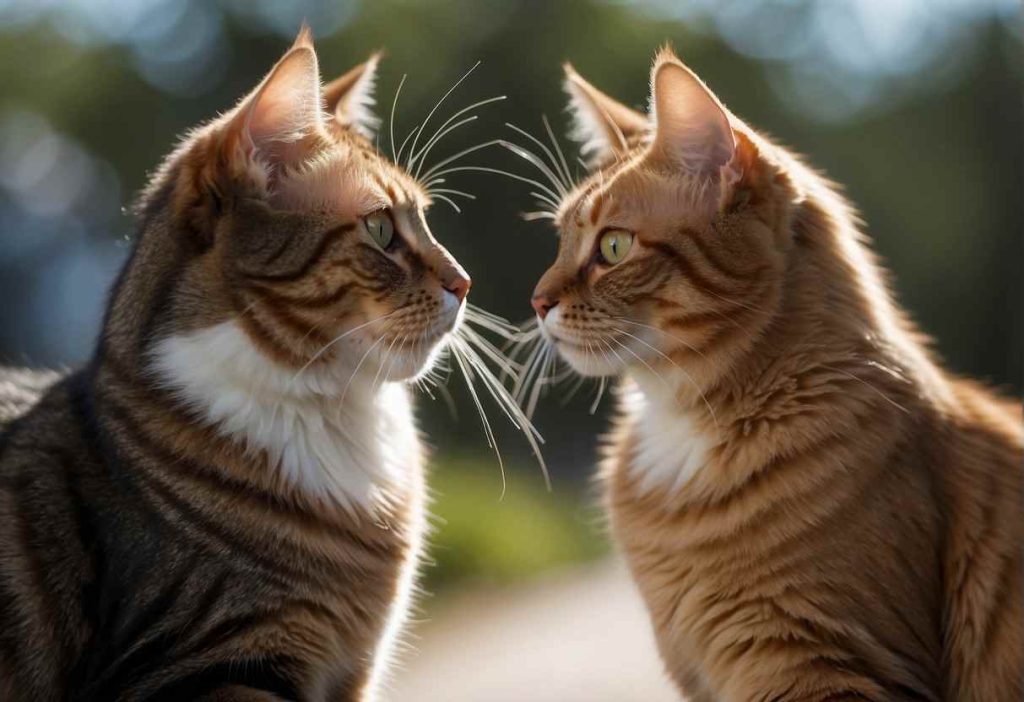
Cat communication is quite an intricate dance, isn’t it? Cats primarily communicate through body language, facial expressions, and vocalizations.
But let’s talk about the vocal part, specifically meowing. This little ‘meow’ can be a gold mine of information!
First off, it’s key to understand that cats typically don’t meow at each other. That’s right, this vocal cue is reserved almost exclusively for you, their human companion.
Have you ever caught your cat in a deep ‘conversation’ with another furry friend? Probably not, because those chats don’t usually happen. Meowing is their special hotline to human ears! (4)
So, why should you tune in to these meows?
For cat owners, recognizing the nuances in your cat’s meows can strengthen the bond between you and your whiskered companion.
- Questions: Hmm, is your cat’s meow urgent or more melodic and languid? Learning their ‘language’ can be quite fun!
- Personal Anecdote: I remember when my cat, Whiskers, would ‘speak’ to me every morning – it was his polite way of demanding breakfast!
Remember, each cat is unique:
- Some may ‘speak’ in soft chirps.
- Others may have a more demanding tone.
But don’t worry, common patterns do exist, and with a bit of attention, you’ll start to catch on. Plus, it’s a fantastic way to show your feline friend that you care.
Ready to become a cat whisperer? Let’s decode those adorable meows together!
Decoding the Cat’s Meow
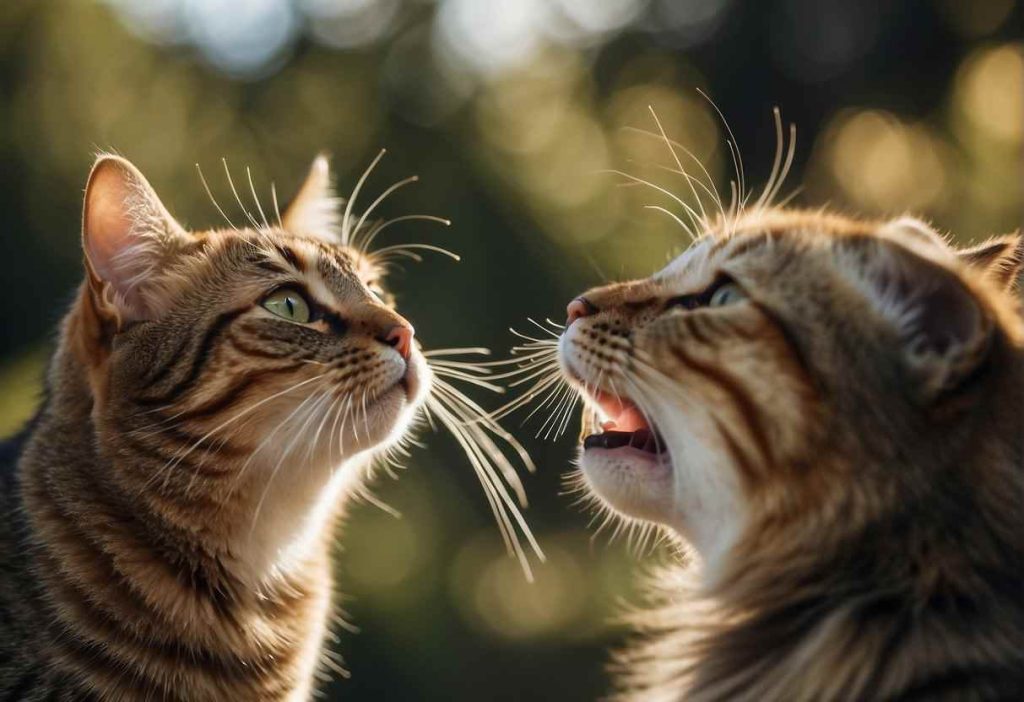
Meowing: A Special Cat-Human Interaction
It turns out, that meowing isn’t typically a cat-to-cat convo. It’s more like a cat-to-you chat!
Cats have developed this adorable way of vocalizing specifically to communicate with us humans.
They’re like that friend who always knows the right thing to say, or, well, meow.
Understanding the Meow
They might not be just random sounds after all. Let’s break down the “meow code”: (5)
- Different Meows for Different Moods: Your cat’s meows can signal anything from a demand for dinner to a simple ‘hello’.
- Short Meow: “Hey, there!” A standard greeting.
- Multiple Meows: “Oh, I’m SO happy to see you!” Think of it as your cat’s version of a warm hug.
- Low Pitch Meow: “You’re not doing well, amigo.” Could hint at a complaint or displeasure.
- High Pitch Meow: Often more urgent, like “I’m STARVING or “Let me out, pronto!”
Now, wouldn’t you love to respond just right and deepen that special bond with your fluffy companion?
Current insights suggest that while we understand some basics, we still need more research for a comprehensive guide. It might not be long before we’re having full-blown chats with our pets!
Remember, each meow is a peek into your cat’s mysterious mind, filled with thoughts, wants, and perhaps a bit of cattitude.
Keeping an ear out for the subtleties in their ‘meow-speak’ can surely turn you into the ultimate cat whisperer.
Isn’t it fascinating how these creatures have honed a special language just for us?
Now, go converse with your kitty—they might just be waiting to spill the tea!
Beyond Meowing: The Spectrum of Cat Communication
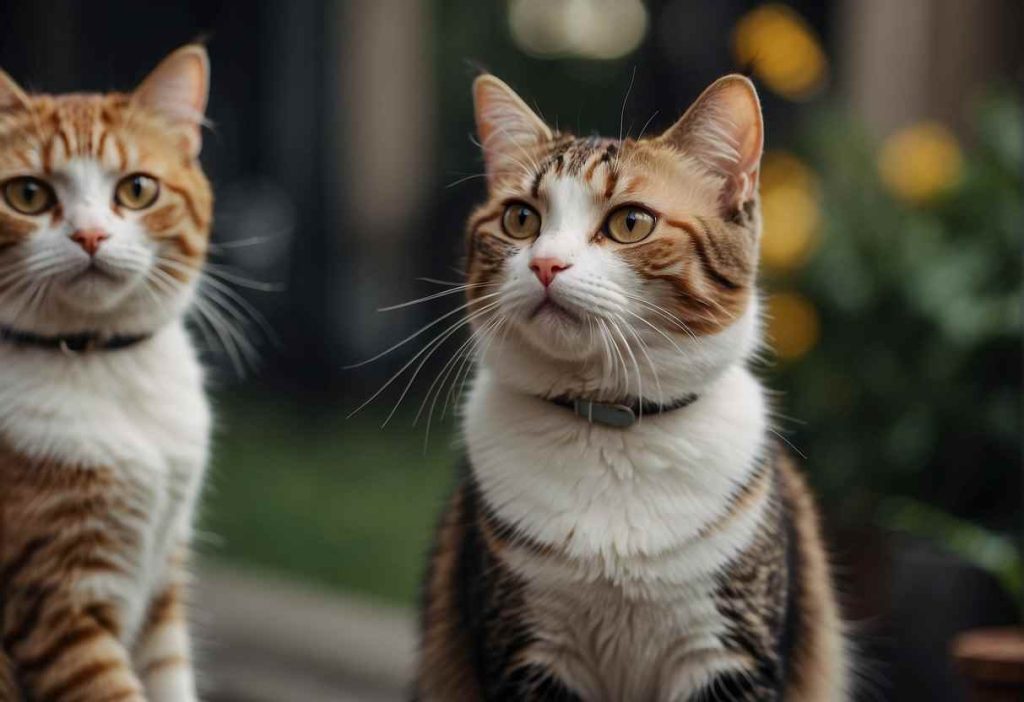
Vocal and Non-Vocal Signals
Cats wield a variety of vocal cues beyond meowing, such as:
- Yowling: often a mating call or territorial statement.
- Hissing: a sign of fear or aggression.
- Purring: commonly associated with contentment.
But wait, there’s more!
Cats communicate volumes through body language:
- Tail Signals: A puffed-up tail indicates fear, while a twitching tail can signal irritation.
- Body Posture: An arched back and fluffed fur mean a defensive stance.
- Eyes: Dilated pupils can be a sign of playfulness or aggression, depending on the context.
They also use scent marking to convey messages to other felines, declaring ‘This is mine!’ without uttering a single meow.
Enhancing Non-Verbal Communication
Curious about cracking the cat code? It’s all about tuning in to their non-verbal cues. Here’s how you can be fluent in cat-talk:
- Observe their body language in different contexts.
- Listen for variations in vocalizations.
- Create a stress-free environment to encourage positive behaviors.
Want to respond in kind?
Try using slow blinks to tell your cat you love them; it’s like a kitty kiss!
Or, mimic their tail movements during play to show you’re in tune.
Remember, when a cat headbutts you, they’re saying ‘You’re part of the clan!’
So, cherish these silent whispers of feline affection. They’re just as important as their iconic meows.
The Evolution of Meowing Throughout a Cat’s Life
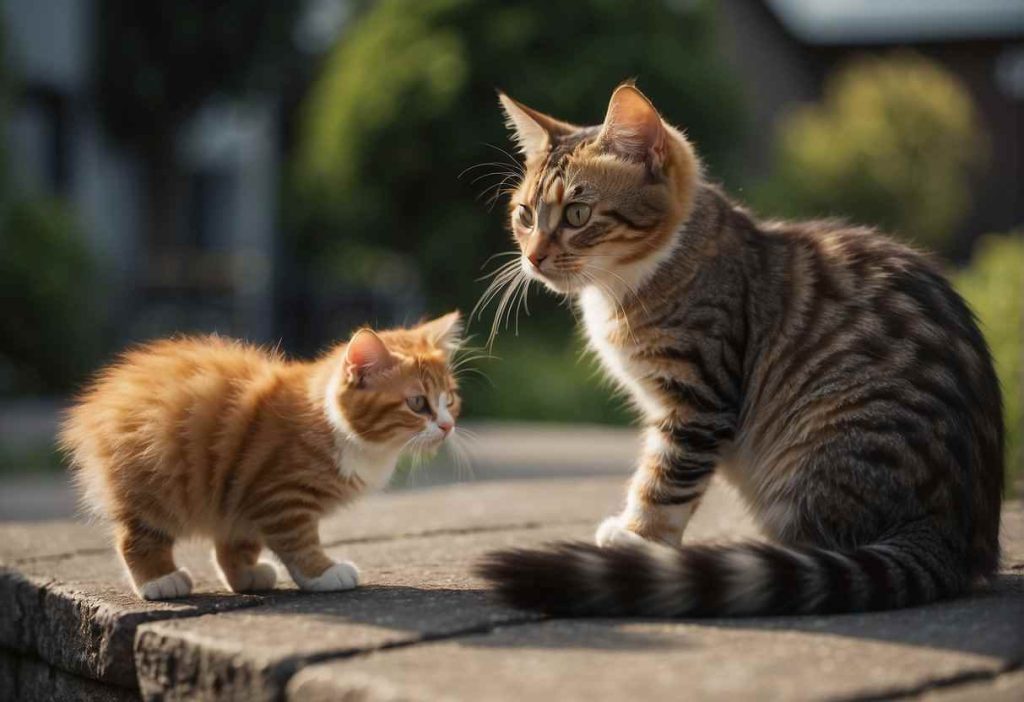
From Kitten to Senior: Understanding Age-Related Changes
When you first meet your kitten, their initial meows usually call for attention, especially from their mother.
Have you ever wondered if that tiny, adorable sound develops into something more over the years?
Let’s take a peek into how these meows mature as cats journey from playful kittens to dignified seniors.
- Kittenhood (0-6 months): Meows are frequent, as they signal the need for food or comfort.
- Adolescence (6-18 months): Your cat might meow less at you as they become more independent.
It’s fascinating to see that as cats grow older, their communication strategies alter.
By adulthood, they mainly meow at humans, not so much at other cats. Instead, they reserve hissing, growling, and purring for their feline friends.
Signs to Spot Through Meows:
- Adulthood (1-10 years): Expect consistent, purposeful meows directed at you, often as greetings or requests.
- Senior Years (10+ years): A change in meows could indicate health issues such as hearing loss or cognitive dysfunction.
So, you might notice your senior cat becoming more vocal. It’s like they’re trying to compensate for their diminished senses. If their meow seems off-key, that’s a cue to check in with your vet.
To sum it up, cat meows transform from being a universal kitten language to a sophisticated human-focused chat tool.
Keep an ear out; those meows are part of the beautiful tale of your cat’s life.
And remember, a change in tune can sometimes be more than just a mood swing; it’s always good to listen closely.
Advanced Strategies for Enhancing Cat Communication
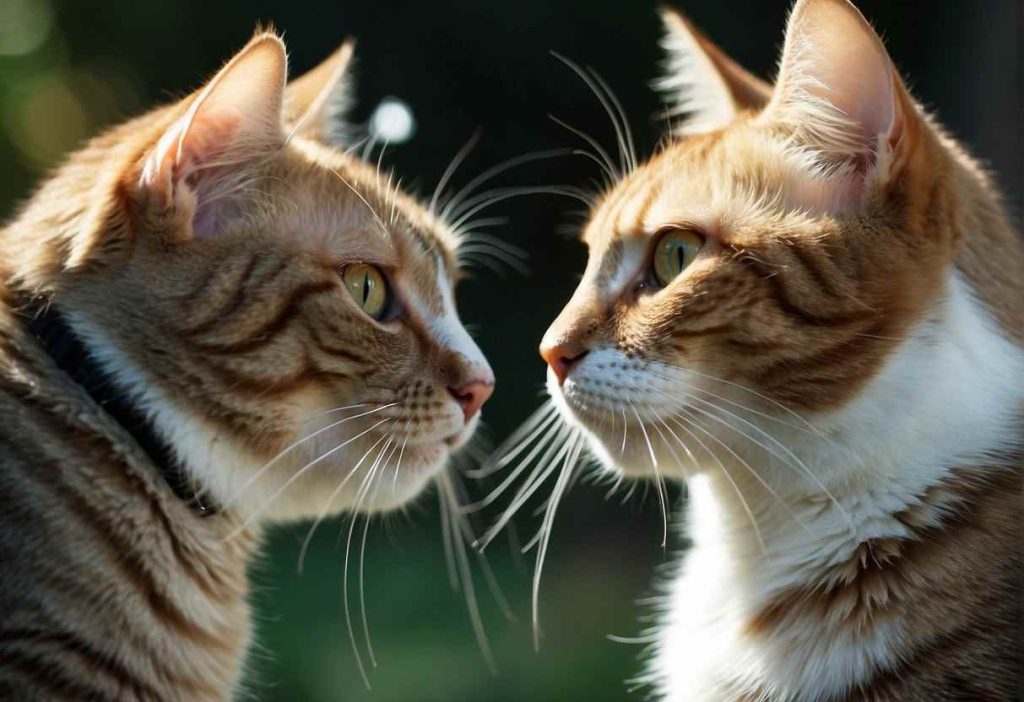
Interpreting Complex Meows
Pay close attention to the pitch, duration, and frequency.
For example, a high-pitched meow usually signifies your cat wants attention or food, while a lower-pitched meow might mean discomfort.
- Quick Tips:
- High-pitched: Often linked to demands for attention or food.
- Low-pitched: May indicate annoyance or discomfort.
- Purring meows: A sign of contentment and closeness.
Keep a meow journal.
Jot down what was happening each time your cat meowed: What time was it? Were you in the middle of something?
Spotting patterns can give you a peek into your cat’s linguistic world!
Non-Verbal Communication Mastery
Cats are masters of body language. The swish of a tail or the perk of ears says a lot. To truly bond with your furry friend, become a student of their silent language.
Here’s a handy guide to what your cat’s body language might be saying:
| Body Language | Potential Meaning |
| Tail straight up | Confidence or happiness |
| Tail puffed out | Fearful or agitated |
| Ears flat | Angry or defensive |
| Slow blinking | Trust and affection |
Remember to mirror your cat’s non-verbal cues to show understanding.
Slow blink back to create a love bridge, or give them space if their ears are flat.
They’ll appreciate your respect for their feelings and the effort you’re putting into the relationship.
By tuning into both their meows and body language, you’ll not just coexist—you’ll converse and connect on a whole new level. Isn’t that what being a cat companion is all about?
Quick Recap
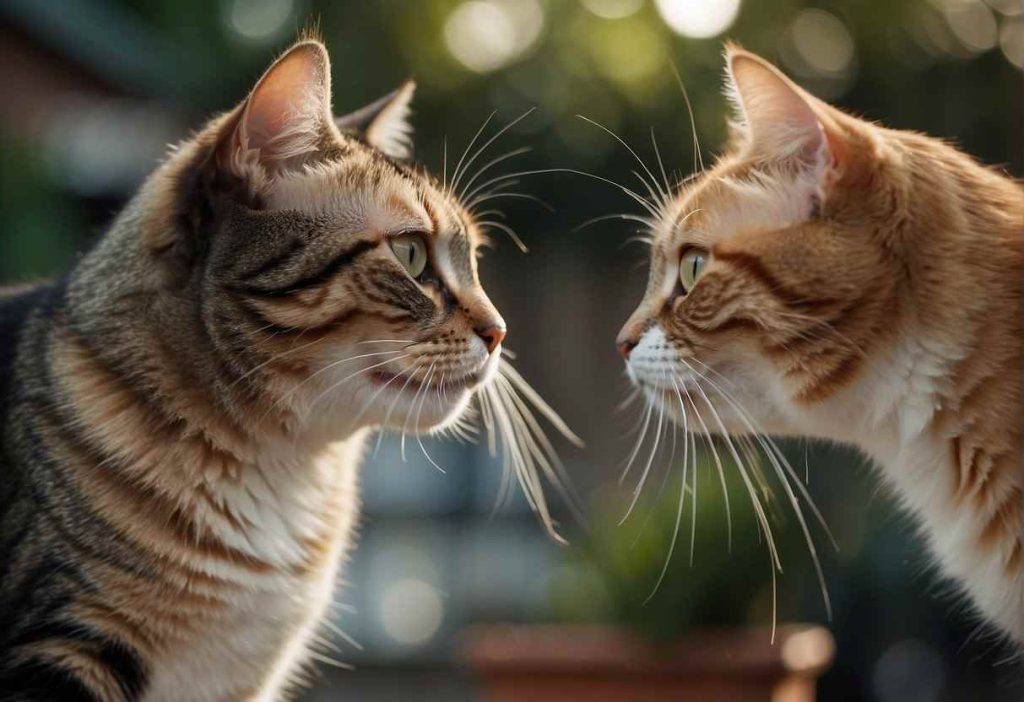
With their furry kin, they’re more about the silent treatment: think body language, scent marking, and the occasional yowl during unfriendly encounters.
Let’s break it down:
- Meow for Me: Cats often meow to start a chat with you or request something.
- Silent Speak: They usually communicate with other cats through non-verbal cues.
- It’s All About Us: Our understanding of their communication helps strengthen our bond.
Why is this cool for you?
- Better Bonding: Understanding your cat’s meows can lead to deeper connections.
- Happy Cat, Happy You: You can respond to their needs better, making for a content kitty.
Remember, your cat meowing is more than just noise; it’s them reaching out to you, and you have the awesome privilege to understand and connect with them on a deeper level. Isn’t that just purr-fect?
Frequently Asked Questions
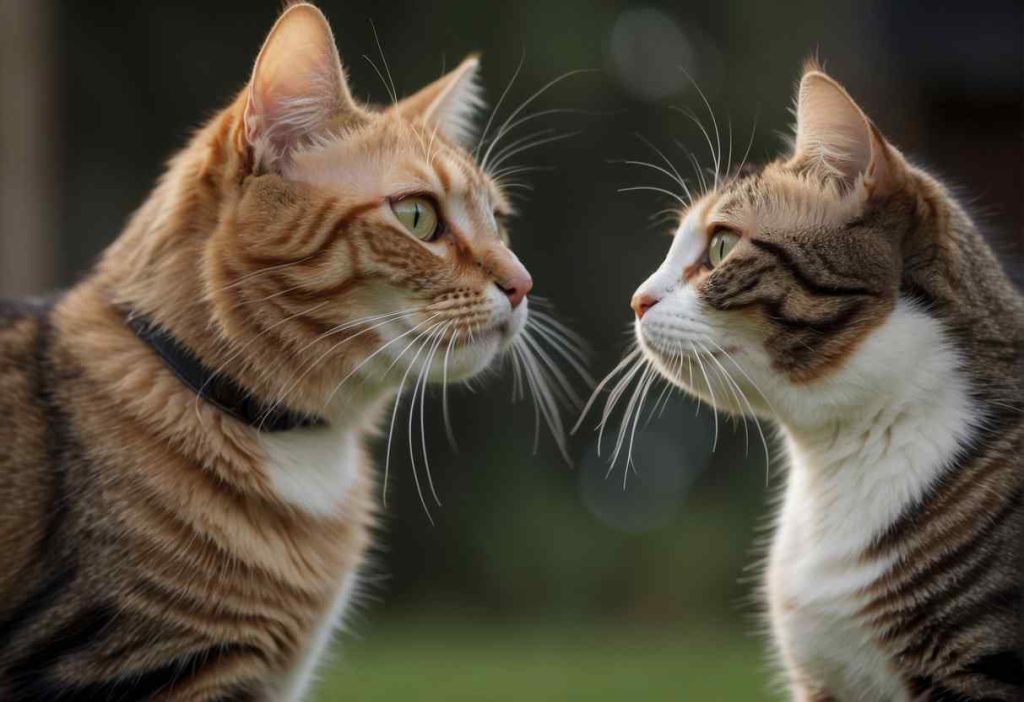
Curiosity is a cat’s best friend, and it seems like it’s yours, too! Let’s jump straight into the pressing questions you have about the meowing mysteries of cats.
Do cats meow at other cats, or is meowing reserved for humans?
You may be surprised to learn that adult cats typically don’t meow at each other. This behavior is reserved for their communications with humans.
What are the main reasons cats meow at humans?
Cats meow at humans for various reasons, such as requesting food, seeking attention, or indicating that something is amiss. Sometimes, it’s just their way of saying hello to you!
How can I tell what my cat’s meow means?
It’s all in the tone, duration, and context. A short meow might be a simple greeting, while a longer one could signal more pressing needs.
Pay attention to what’s happening around you when your cat meows to decode its message
How do cats communicate with each other if not through meowing?
Cats have a repertoire of sounds for feline-to-feline chats, like hisses, growls, and purrs. They also communicate through body language, scent marking, and facial expressions.
How does a cat’s meowing behavior change as they age?
Kittens meow a lot to communicate with their mothers, but as they grow older, they typically meow less with other cats and more with humans.
Senior cats might meow more due to confusion or health-related issues
Is it possible to train a cat to meow less?
You bet! Paying attention to your cat’s needs proactively and using positive reinforcement can reduce excessive meowing.
Try not to respond to meows all the time, as this can encourage more vocal demands.
Can understanding my cat’s meows improve our relationship?
Absolutely! Responding appropriately to your cat’s meows can strengthen your bond.
It shows your furry friend that you’re attentive to its needs and communications.
Why do cats meow at other cats?
Cats meow at other cats as a form of communication, signaling their presence, seeking attention, expressing social hierarchy, or showing interest in mating.
Meowing at other cats can convey various emotions and intentions, helping them interact and establish connections within their social group.
- Free Online Casino Games: What You Need to Know - July 26, 2025
- Ideal Casinos Mobile: The Ultimate Guide to Mobile Betting - July 26, 2025
- The Ultimate Overview to Casino Site Gamings Online - July 26, 2025

